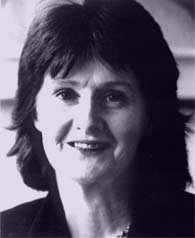English
WIU Home > CAS > English > Case > Biographies

Eavan Boland, Spring 2002
The inaugural event in the Fred E. and Lola Austin Case Residencies occurred April 4 and 5, 2002, when Irish poet Eavan Boland visited campus. Boland is the author of more than a dozen books of poems, among them Against Love Poetry ( 2001), The Lost Land (1998), and In a Time of Violence (1994). She has also authored a collection of essays about poetry, Object Lessons: The Life of the Woman and the Poet in Our Time (1995), and she is coauthor (with Mark Strand) of The Making of a Poem: A Norton Anthology of Poetic Forms. Eavan Boland is one of the most distinguished voices in contemporary poetry. The daughter of an Irish diplomat (he was at one time Ambassador to England), she grew up in Ireland and was educated at Trinity College.
Her work has especially focused on Irish history and women in Ireland and the modern world. At an initial afternoon meeting on April 4 in Simpkins Hall, Boland answered questions about writing, the writing life, and the craft of poetry from a large and enthusiastic audience of students. Her public reading in Horrabin Hall Theatre that night revealed a deep engagement in the violent and troubled history of her country and in the life of the women in her family. An audience of 150 people heard poems about the famine, about her grandmother, and from her most recent book, Against Love Poetry, poems about the deep persistence of love and marriage in difficult times. On the morning of April 5th, Boland lectured to students, faculty, and townspeople on the violence in Ireland, which she witnessed first-hand as a young reporter in Dublin. She talked about the responsibilities of writers in the modern world, and our collective responsibilities as people.
Throughout the two-day visit, Boland proved to be generous and accessible. Apprentice writers learned new things about their craft, and benefited from the personal example of a seasoned professional writer. She brought the larger world to our community in a particularly exciting way.

Connect with WIU: